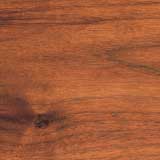|
Walnut can add drama and interest when combined with the beauty of other hardwoods. Known as the American Black Walnut, Juglandaceae J. nigra, the Walnut is the superior choice in cabinets as it is hard, heavy, strong, compact and durable. It is also known as American Walnut, Virginia Walnut, Canaletto, Black Hickory Nut, and French Walnut. There are 20 species of Walnuts. The trees are usually 80 – 100 feet tall with trunks less than three feet.
No other wood responds as beautifully to finishing, sanding, turning and carving as the Walnut. This wood is tough and hard and has moderate bending and crushing strengths. It has good steam bending characteristics. With special care, the sapwood and heartwood can be combined. The Walnut produces more figure variation than any other wood. It is often combined with other, light-colored woods. Walnut is used in high-quality furniture, cabinets, boats, architectural millwork, doors, flooring, paneling, musical instruments, clock cases, turning, carving, veneers, and other products. Because of its reputation for stability and shock resistance, it is the choice in the United States for gunstocks. Crafters often choose this wood for its ease of use. The luster of the beautiful Walnut grows with age. The Black Walnut heartwood is a rich dark brown to purplish-black and is usually straight grained. Wavy or curly grain is sometimes present. Often, Walnut is steamed in order to darken the sapwood. Care must be taken with Walnut, as it dries quite slowly, to avoid kiln degrade. The wood is very durable although the Sapwood is susceptible to attack by the powder post beetle. Heartwood is sometimes resistant to preservative treatment and biodegradation. Found throughout the Eastern United States, the Walnut does not grow in strands. The individual trees are shorter, 100 to 150 feet, and usually of medium diameter. These differences have resulted in special grading rules for Walnut. The FAS guide allows a 6' long board and shorter clear-face cuttings. The lower grades of Walnut, No. 1 and No. 2, are marked with knots, burls and wavy grain which are desirable in Walnut. This is one of the few species of hardwood that is naturally regenerated and planted. |

